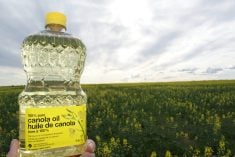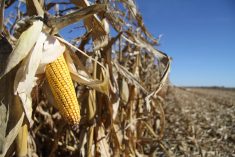Canadian growers would likely benefit from the new measures if the EU focuses on biofuel that uses crops such as canola
The European Commission wants to double the amount of renewable energy sources in its overall energy mix but it remains uncertain what that might mean for Canadian canola demand.
Earlier this year the commission published a proposal to revise the Renewable Energy Directive to include a target of 40 percent renewables by 2030, up from 19.7 percent in 2019.
In particular, the revision focuses on sectors where progress in integrating renewables has been slower to date, such as transport, buildings and industry.
“The steady renewables evolution of recent years and decades must become a revolution,” EU commissioner for energy Kadri Simson said in a July news release.
Read Also

Flax sector sees omega-3 opportunity
SASKATOON — A global shortage of omega-3 oils could be an opportunity for the flax sector, says an industry official….
The EU most likely achieved its previous target of a 20 percent renewables share by 2020 with figures from 2019 (which is the most recent data) showing a 19.7 percent share.
But there is lots of variability by sector with electricity achieving a 34 percent share while the transport sector was just 8.9 percent.
The new proposal calls for a 28 percent renewables target for the transportation sector by 2030.
A large portion of the current renewables portion of the transport sector is being met by biofuels.
So on the surface it appears as though the new targets would be a huge boon for the biofuel sector, which is dominated by rapeseed/canola-based biodiesel.
The EU has rapidly become one of Canada’s top markets for canola due to demand from the biodiesel sector.
In 2020 it imported 2.52 million tonnes of the oilseed, making it Canada’s second biggest customer behind China’s 2.58 million tonnes.
Sales tailed off in 2021 due in part to COVID restrictions on travel and a sharp reduction in commuting to work. The EU imported 523,945 tonnes of Canadian canola through the first nine months of the year.
On the surface, the new commission proposals would appear to be good news for Canadian canola farmers and exporters but there is a catch.
The EU has capped the share of conventional, crop-based biofuels at one percent above 2020 levels up to the overall cap of seven percent of final consumption of road and rail transport fuels.
That means much of the growth in the transport fuel sector would likely come from biofuels made with used cooking oil and animal fats rather than crops, as well as other sources of renewable energy like electric and hydrogen powered vehicles.
Chris Davison, vice-president of stakeholder and industry relations with the Canola Council of Canada, said the devil is going to be in the details of the new directive.
The commission’s proposals have yet to be vetted by the member states and the European Parliament.
“We would like to hope that European Union imports of biofuel feedstock will remain a component,” he said.
But right now it is unclear how imported feedstock will be treated under the new directive.
“What it ultimately looks like from our perspective remains to be seen,” said Davison.
“It ultimately depends on how this is implemented.”
For instance, when it comes to sustainability requirements it is uncertain whether the new directive will recognize regional cultivation practices rather than burrowing down to individual farm-level data.
It is also unknown how the EU will treat voluntary certification schemes.
“We’re really keen to see how this evolves and what it looks like in terms of implementation,” said Davison.
Currently, canola/rapeseed oil is the feedstock of choice for the EU biodiesel sector, with an estimated 5.8 million litres consumed by the sector in 2021, according to the U.S. Department of Agriculture.
That represents 39 percent of all the feedstock. Other popular feedstocks are used cooking oil, palm oil and animal fats.
















